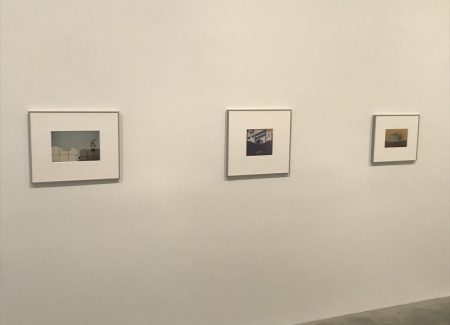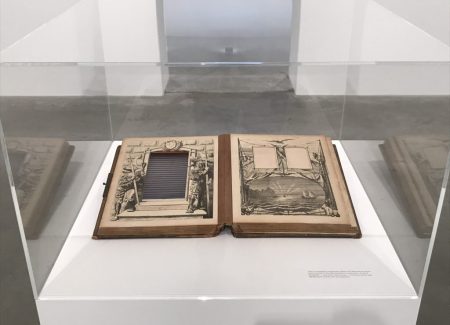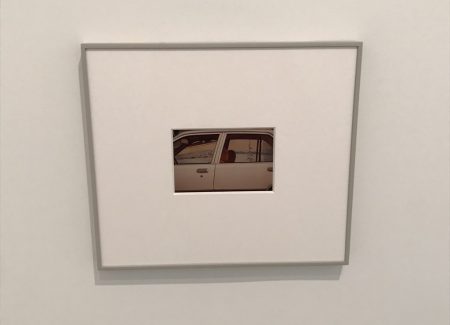JTF (just the facts): A total of 29 color photographs, framed in grey and matted, and hung against white walls in the main gallery, the back gallery, and the entrance area. 25 of the works are c-prints, 3 are cibachrome prints, and 1 is a Polaroid print. The images were made between 1970 and 1991. Physical sizes range from roughly 4×6 to 24×21 inches (or the reverse), and no edition information was provided on the checklist. The show also includes two vitrines containing 1 coloring book, 1 commercial catalog, 1 graphite and crayon drawing on paper, 1 exhibition announcement with ink and photograph on paper, and 1 photo album. (Installation shots below.)
Comments/Context: The photograph on the front wall of the current Luigi Ghirri exhibition at Matthew Marks captures a pair of hands assembling a 19th century family portrait daguerreotype. One hand holds the metal frame, while the other pushes in the black backing material, bringing the shape of the mother and child into clear view (the father is still a ghostly silhouette). It is a photograph of a photograph being assembled, and the work crisply introduces the theme of this show – it is an examination of the Italian photographer’s interest in building pictures, in one form or another. Curated by the painter Matt Connors, whose abstractions have their own ongoing dialogue with modes of construction, the show gathers together a tightly edited range of photographs that see the world around us as a series of built realities and image objects.
Ghirri’s repeated interest in stage sets and arranged rooms often manifests itself as an exercise in perception, where layers of artificiality and picture making are confoundingly nested. When he shows us a wooden theater stage, it is framed frontally, so we telescope into its controlled environment, simultaneously inside and out; the same can be said of Ghirri’s colorful photograph of a disco, where the dance floor leads us to a seating area bathed in pink light. Images of a cluster of music stands in a pavilion, the back of a billboard, and a densely packed music studio are all “behind the scenes”, and yet are shown to us as places in and of themselves. Even locations that aren’t overtly performative, like the assembly line at a Ferrari factory or a tiered loggia, become stages for Ghirri, with the red hood of a car centrally framed with receding lines of perspective on the ceiling, and the balconies, stairways, and checkerboard decorations of the loggia twisted into an impossible visual tangle worthy of M.C. Escher.
In other works, Ghirri’s framing is more openly playful. He looks out the window at Versailles, placing the cross of the window panes directly in the center of the image, deliberately (and intrusively) breaking the view up into four quadrants. He uses the windows of a car (both driver and back seat) to frame the landscape in a painted mural behind it. And he seems to relish the opportunity to make a picture within a picture – in a photograph of a painting shadowed by an umbrella, a picture of a framed image of an arched walkway placed within an arched brick window, and an image of window blocked by a metal security screen. A rare, extra large Polaroid print doubles this idea one step further, with a sunset postcard placed atop a painted sunset (both aligned at the horizon), the nested composition then photographed by Ghirri one more time.
Another version of Ghirri’s constructed image theme comes in the form of images that are objects. He discovers a table with a painted portrait on top, beds with oval paintings on the head and footboards (with an image of Jesus watching over them), and a paper diagram hung from the edge of a bookshelf. The photographs get more surreal and disorienting when Ghirri shows us a starry sky that turns out to be crinkled wrapping paper, an image of a brass horn hung from a wire, and an eye (a fragment of an optician’s sign) hanging in mid air. He similarly reconsiders various painted murals, from a swirling globe to a disappearing drum set, forcing us to oscillate between the image and its physical reality. A pair of vitrines further examines this image/object interest, with a commissioned tile catalog filled with Ghirri images and an exhibition announcement hand crafted to look like a passport.
For those used to contemporary obviousness and brash visual exaggeration, Ghirri’s wry humor and conceptual cleverness can feel quiet and understated, to the point of almost being overlooked. His photographs require a recalibration to more moderate rhythms, but once we are tuned into his frequency, the strangeness and quirky eccentricity he consistently sees emerges with surprising force. Connors has done an admirable job here of assembling a group of lesser known pictures that holds together well, probing the backwaters of Ghirri’s archive while highlighting a rich vein of the photographer’s intricate thoughtfulness.
Collector’s POV: The prints in this show are generally priced between $10000 and $20000 each, with the large Polaroid print at $40000. Ghirri’s prints have only been sporadically available in the secondary markets in recent years, with prices ranging from roughly $1000 to $55000.





























Great review of my favorite photographer. Had the amazing opportunity to spend time at his home with his late wife and daughter, Adele , back in the late nineties. Such a shame he left us much too soon.
I am lucky to have a Ghirri photo and all his books, they are providing me with a welcome escape from the craziness going on in our country now. Keep the reviews coming and thank you.